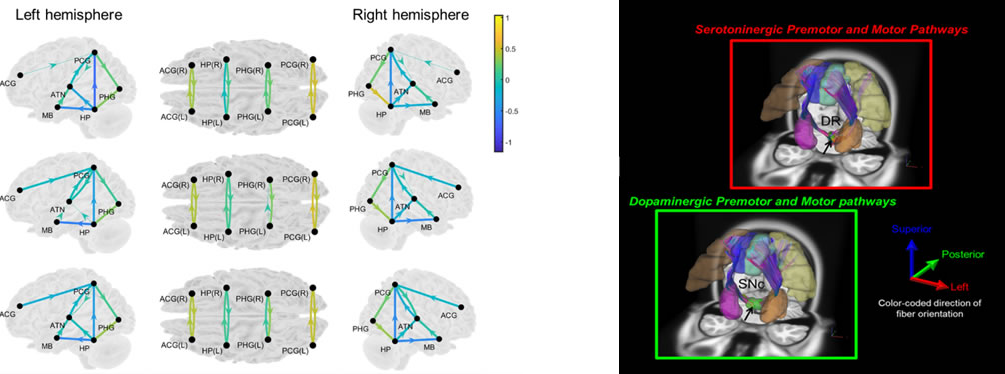臨床腦映像和神經計算實驗室
- 地址:元智大學元智六館61002研究室
- 電話:03-4638800轉6602
The Clinical Neuroimaging and Neurocomputing Laboratory (CNN) applies high-angular resolution diffusion imaging (HARDI) and resting-state Blood-Oxygen-Level-Dependent functional MRI to investigate brain connectomic changes resulted from various neurodegenerative diseases, such as movement disorders, dementia, and epilepsy. With the improved insight into neuropathophysiology provided by the multi-contrast brain MRI, one line of our research aims to enhance the precision medicine in the diagnosis, risk stratification, and prognosis by using deep/machine learning algorithms; another line aims to investigate neuromodulatory effects after interventions of transcranial magnetic stimulation and deep brain stimulation (DBS) to evaluate therapeutic efficacy and make meaningful clinical decisions.
Dr. Yao-Chia Shih is an assistant professor of Graduate Institute of Medicine, Yuan-Ze University with research interest in exploring imaging biomarkers of Parkinson’s disease, Parkinsonian disorders, dementia, and epilepsy to track disease progression by combining multi-contrast MRI with deep/machine learning algorithms.
Our ongoing and upcoming projects focus on the following topics:
1. Investigating neural substrates of divergent disease manifestations in idiopathic Parkinson’s diseases
- Parkinson’s Disease (PD) is a common and worldwide neurological disorder, and its etiopathology is poorly understood. There is growing evidicen that PD has been characterized by dopaminergic neurodegeneration due to intracellular α-synuclein aggregates and Lewy body formation in the substantia nigra pars compacta, leading to striatal impairments via nigrostriatal pathway, thereby resuting in a broad range of motor symptoms. The neuropathology of PD starts from the olfactory nucleus and medulla, spread to basal ganglia ,and then to cortical regions. The affected neurotransmissions beyond the dopaminergic system include serotoninergic, norepinephrinergic, cholinergic, and glutamatergic systems. Hence, deficits in multiple neurotransmissions can cause heterogeneous manifestations of motor and non-motor symptoms, which make therapeutic treatments more challenging. As the discovery regarding neural correlates of clinical symptoms along PD progression is wanting, our lab aims to apply high-angular resolution diffusion imaging (HARDI) and resting-state functional MRI to systematically investigate microstructural/functional changes in brain networks responsible for different neurotransmissions. These brain abnormalities could be served to associate with clinical variables to identify potential imaging biomarkers.
- Next, we aim to investigate in brain structural and functional reorganization in the above neurotransmissions after performing repetitive Transcranial Magnetic Stimulation (rTMS) in healthy controls and patients with idiopathic PD and/or other Parkinsonian disorders to validate MRI findings.
2. Harmonization of multi-site diffusion MRI and T1 data using deep/machine learning approaches
- The limited sample size and heterogeneous demography lead to insufficient generalizability and reproducibility of findings reported by neuroimaging studies using single-site data. Recently, to increase sample size and reduce time-consuming data collection, the emerging and challenging research topic of data harmonization aims to integrate multi-site MRI data accounting for the scanner-, vendor-, acquisition-, and other site related differences in brain structural measurements. Our lab aims to harmonize T1 and diffusion MRI data collected from the multiple local sites with the data released from UKbiobank, ADNI, HCP, PPMI, and CAM-CAN databanks. Specifically, Dr. Shih is interested in the optimization of CycleGAN network to conduct T1 data harmonization, and in the data fusion of multi-shell diffusion weighted images with and without multi-band acquisitions to overcome lower spatial (> 2 mm^3) and angular resolutions (< 64 diffusion-encoded directions) in clinical diffusion MRI protocol.
- In addition, once the diffusion MRI data harmonization has been optimized, our lab aims to merge these datasets together to construct the normative white matter template associated with normal ageing and apply this template to utilize individual diagnosis of neurodegenerative diseases.
3. Deep learning platform to predict progressive changes in brain structures and functions in dementia.
- Tracking the progression of neurogenerative diseases related to ageing by return visits over decades has negative impacts on healthcare costs and patients’ quality of life. As 3D convolutional neural network and variational autoencoder have been widely applied to predict disease occurrence and progression using structural and functional neuroimaging data, Dr. Shih is interested in integrating multi-modal MRI data together with clinical variables and neuropsychological scores as inputs to establish deep-learning platforms to estimate the risk of getting dementia and/or simulate progressive brain structural and functional changes in the following years by using T1, HARDI, and resting-state functional MRI data collected at the baseline.


